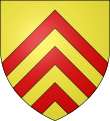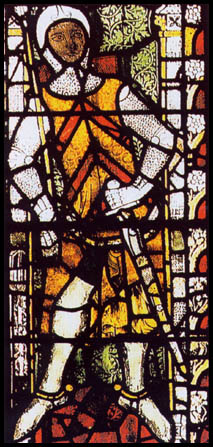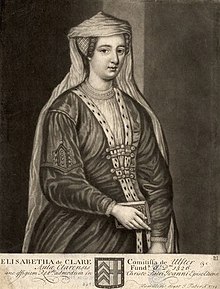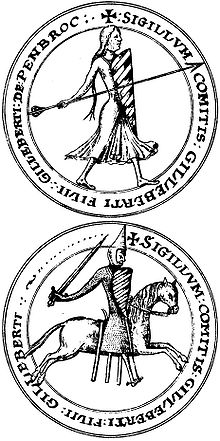
Earl of Pembroke is a title in the Peerage of England that was first created in the 12th century by King Stephen of England. The title, which is associated with Pembroke, Pembrokeshire in West Wales, has been recreated ten times from its original inception. Due to the number of creations of the Earldom, the original seat of Pembroke Castle is no longer attached to the title.

Gilbert de Clare, 4th Earl of Hertford, 5th Earl of Gloucester, 1st Lord of Glamorgan, 7th Lord of Clare was the son of Richard de Clare, 3rd Earl of Hertford (c. 1153–1217), from whom he inherited the Clare estates. He also inherited from his mother, Amice Fitz William, the estates of Gloucester and the honour of St. Hilary, and from Rohese, an ancestor, the moiety of the Giffard estates. In June 1202, he was entrusted with the lands of Harfleur and Montrevillers.
Earl of Clare was a title of British nobility created three times: once each in the peerages of England, Great Britain and Ireland.
Richard de Clare may refer to:
Richard de Clare, 2nd Earl of Pembroke, also Lord of Leinster and Justiciar of Ireland, was an Anglo-Norman nobleman notable for his leading role in the Anglo-Norman invasion of Ireland. Like his father, Richard is commonly known by his nickname, Strongbow.
Richard de Clare, 3rd Earl of Hertford, feudal baron of Clare in Suffolk, and lord of Tonbridge in Kent and of Cardigan in Wales, was a powerful Anglo-Norman nobleman with vast landholdings in England and Wales.
Roger de Clare, 2nd Earl of Hertford, 5th Lord of Clare, 5th Lord of Tonbridge, 5th Lord of Cardigan (1116–1173) was a powerful Anglo-Norman noble in 12th-century England. He succeeded to the Earldom of Hertford and Honor of Clare, Tonbridge and Cardigan when his brother Gilbert died without issue.

Gilbert fitz Gilbert de Clare, was created Earl of Pembroke in 1138.
Richard fitz Gilbert, 1st feudal baron of Clare in Suffolk, was a Norman lord who participated in the Norman conquest of England in 1066, and was styled "de Bienfaite", "de Clare", and of "Tonbridge" from his holdings.
Gilbert Fitz Richard, 2nd feudal baron of Clare in Suffolk, and styled "de Tonbridge", was a powerful Anglo-Norman baron who was granted the Lordship of Cardigan, in Wales c. 1107–1111.
Richard fitz Gilbert de Clare 3rd feudal baron of Clare in Suffolk, was an Anglo-Norman nobleman. A marcher lord in Wales, he was also the founder of Tonbridge Priory in Kent.
Gilbertde Brionne, Count of Eu and of Brionne, was an influential nobleman in the Duchy of Normandy in Northern France. He was one of the early guardians of Duke William II in his minority, and a first cousin to William's father Duke Robert. Had Lord Brionne not been murdered, the senior house of de Clare would probably have been titled de Brionne. Lord Brionne was the first to be known by the cognomen Crispin because of his hair style which stood up like the branches of a pine tree.
Baldwin de Redvers, 1st Earl of Devon, feudal baron of Plympton in Devon, was the son of Richard de Redvers and his wife Adeline Peverel.
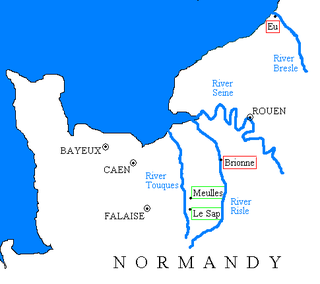
Baldwin FitzGilbert was a Norman magnate and one of the 52 Devon Domesday Book tenants-in-chief of King William the Conqueror, of whom he held the largest fiefdom in Devon, comprising 176 holdings or manors. He was feudal baron of Okehampton, seated at Okehampton Castle in Devon.
Isabel de Clare, suo jure 4th Countess of Pembroke and Striguil, was an Anglo-Norman and Irish noblewoman descended from Aoife Macmurrough and Richard de Clare and one of the wealthiest heiresses in Wales and Ireland. She was the wife of William Marshal, 1st Earl of Pembroke, who served three successive kings as Marshal of England. Her marriage had been arranged by King Richard I.
Maud de Lacy was an English noblewoman, being the eldest child of John de Lacy, 2nd Earl of Lincoln, and the wife of Richard de Clare, 5th Earl of Hertford, 6th Earl of Gloucester.

Baldwin of Clare was the youngest son of Gilbert Fitz Richard, of the elder branch of the line of Gilbert, count of Eu, grandson of Richard the Fearless.
The feudal barony of Gloucester or Honour of Gloucester was one of the largest of the mediaeval English feudal baronies in 1166, comprising 279 knight's fees, or manors. The constituent landholdings were spread over many counties. The location of the caput at Gloucester is not certain as Gloucester Castle appears to have been a royal castle, but it is known that the baronial court was held at Bristol in Gloucestershire.
Rohese Giffard was a Norman noblewoman in the late 11th and early 12th century. The daughter of a Norman noble, she was the wife of another Norman noble, Richard fitzGilbert, who was one of the ten wealthiest landholders there after the Norman Conquest. Rohese is mentioned in Domesday Book as a landholder in her own right, something uncommon for women. She and Richard had a number of children, and she lived on past his death around 1086, until at least 1113 when she is recorded giving lands to a monastery. Her descendants eventually inherited her father's lands, although this did not occur until the reign of King Richard I of England.
